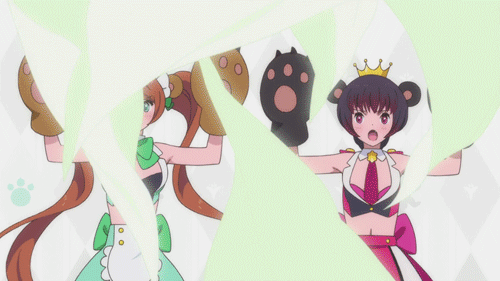 Gif taken from this tumblr
Gif taken from this tumblr
Ikuhara Kunihiko does not direct anime often, but when he does they almost inevitably end up being very abstract, theatrical, and full of hidden and disguised themes. Best known for Revolutionary Girl Utena and Mawaru Penguindrum, this season he comes at us with a new series, Yuri Kuma Arashi. It brings to us exactly what is in its title: lesbians, bears, and some kind of invisible storm.
Episode 1 is extremely disorienting with a lot of seemingly strange decisions. It’s easy to jump on the keyboard and begin typing out how wacky or bizarre the series is. However, while I don’t want to stop anyone from writing their feelings on the show from week to week, I want to warn my fellow anime fans, whether they’ve got blogs, vlogs, podcasts, or maybe even some kind of anime review diary (???) that it is best not to approach Ikuhara’s anime as if they were any other works. This might some a bit pompous or pretentious but I really mean it, especially in light of how episode reviews of Mawaru Penguindrum generally went.
When Mawaru Penguindrum originally aired, I would see reviewers pick apart the show each week, asking something like, “Was episode 8 better than episode 7? Well, the characters didn’t really develop more, so probably not!” People ended up focusing on small, almost pointless details and missing the bigger picture, because they were used to how a typical anime might try to improve itself from week to week. Ikuhara’s anime don’t really work that way.
One thing to watch out for is repetition. Often times, whether it’s use of stock footage or just having characters repeat some process episode after episode, this is generally not merely a time-saving measure nor solely visual flourish but something that gains meaning through that repetition. Ikuhara also likes to build in subtle hints towards the truth of what his series are about, while throwing in a few red herrings. Why would he do that? Because truths and lies and the the blurring of fantasy and reality are big themes of his, practically as big as girls loving other girls.
Given that we only have one episode I, like everyone else, don’t have much material to work with at the moment. I don’t intend to episode review Yuri Kuma Arashi, but I’ll say a few things I found notable that I think are worth keeping track of for this show. First, yuri is often something of an undertone in Ikuhara’s works, but this time it is front and center, to the extent that it appears in the title. It’s overt, maybe too overt if you get where I’m going: it is likely going to be tied to some greater concept than solely girls’ love. Second, the distinction between (yuri) girls and bears and the whole theme of “eating.” Yes, the imagery is clearly meant to imply some serious sexual activity, but why make that metaphor, and why contrast it against the chaste-looking beauty of a girls-only world? Third, consider the concepts of “Life Beauty,” “Life Sexy,” and “Life Cool,” as they pertain to how people view yuri as a genre and lesbian relationships. For more speculation from reviewers more familiar with Ikuhara’s works, check out the Reverse Thieves’ S.W.A.T. Review of Episode 1, who also helpfully ask the question why the only men in the series so far are there to judge the interactions between girls.
Again, it’s not an impossible task to review each episode of Yuri Kuma Arashi, but don’t take the show lightly, and don’t write it off as if it’s merely a vehicle for fanservice. Obviously I can’t say how the show will turn out, but don’t go seeing the inevitable twist and thinking, “But that came out of nowhere!” In all likelihood, it really didn’t.

In one of Anime News Network’s forums, I read a commenter’s assessment that Yurikuma Arashi’s symbolism is ‘pretty straightforward’ for Ikuhara, with Life Cool, Sexy, and Beauty representing the Id, Ego, and Super-ego, the girls’ bear forms representing carnal sexuality, and their girl-forms representing socially-acceptable sexuality. The Wall of Severance/Extinction is apparently sexual repression, and if any of that’s true, it’ll make the metaphors that much easier to understand and analyze.
LikeLike